Attack of the 109s Pt. 7: The Avia S-199 1/32 conversion of Hasegawa kit
The Czechs called it "Melec" (the mule), the Israelis called it the "Shakeen," (knife). It was nearly the last of the line.
As bad a fighter as it might have been, its arrival in Israel changed history. Here's an account of that I wrote:
The Egyptian Army thought they would smash Israel in a matter of weeks following the outbreak of war after the May 14,1948 declaration that created the State of Israel. They came close. In the late afternoon of May 29, 1948, the Egyptian Army’s Second Brigade, equipped with 10 tanks and nearly 500 other armored vehicles, was less than 30 kilometers from Tel Aviv. They were held back by a blown bridge outside the village of Ashdod, and faced only the lightly armed survivors of the Givati Brigade of the Haganah. It was only a matter of hours before the pontoon bridge the Egyptians were assembling would be operational. When the tanks came across, the Givati Brigade would have no choice but to retreat, leaving the road to Tel Aviv open. There was no Israeli force left that could stop the advance. The Egyptian soldiers didn’t even look up at the sound of aircraft engines in the near distance, knowing they could only be Egyptian, probably sent to attack the Israelis and cover the river crossing. One fighter approached from the north, flying low toward the Egyptian units inside Ashdod. Suddenly, the wings flashed fire and 20mm cannon-shells ripped through the assembled troops! As the airplane flashed overhead, it dropped two 70-kilogram bombs in the midst of the Egyptians. Those who could look up were amazed to see the blue Star of David on the wings of the fighter as it turned for a second attack. In the cockpit, American volunteer Lou Lenart lowered the nose and opened fire as he turned and approached from the southeast. Opposition in the form of intense 40mm anti-aircraft fire finally came up as he wheeled around for a third pass. After firing 10 rounds on this pass, the 20mm cannons slung under the wings jammed.
As Lenart flew away, Israeli pilot Modi Alon came in from the northeast and attacked the vehicles just south of the bridge. Flying through intense flak, Alon made two more strafing passes before running out of ammunition. As Alon made his third pass, Ezer Weizman attacked from the south, dropping one bomb on vehicles south of Ashdod. On his second pass he hit the units close to the bridge. While his cannons fired only one shot each before jamming, Weizman strafed with the two 13mm cannons his airplane was equipped with. The fourth airplane, flown by American Eddie Cohen, was not so fortunate. Hit badly by 40mm fire on his second strafing pass, the airplane was seen trailing smoke as it flew off to the north.
Lenart covered the 20 kilometers from Ashdod to the secret air base at Ekron in a matter of minutes. He landed just in time to see Modi Alon suffer failure of his left brake as he touched down. Unable to steer a straight path down the runway, Alon ground-looped the fighter, the left tire exploded, and the wingtip struck the ground as he slewed to a stop, severely damaging the airplane. Minutes later, Weizman landed without incident. Everyone looked for number four, but there was no sign of Cohen. The telephone rang. It was Hatzor air base, reporting that an aircraft engulfed in flames had crashed near the field attempting the land. Two infantry platoons had been sent to rescue the pilot, but the Egyptians had gotten there first. Eddie Cohen was the first casualty of the new Heyl Ha-Avir.
The S-199 entered the history books as more than an afterthought because of the need of the Israelis for any fighter they could lay hands on. Following the UN declaration in the fall of 1947 setting the establishment of the Jewish State for the following May, an arms race developed between the fledgling state and their Arab opponents, who were determined to strangle the baby in its crib. An international arms embargo was declared, but it only affected the Jews. Egypt, Jordan, and Syria already had established armed forces that vastly outnumbered anything the Jews could create with their underground army, the Haganah. In late 1947, Haganah agent Otto Felix, who was searching for arms in central Europe, reported the existence of the S-199, and that the Czechs - who were in need of hard currency - might be willing to overlook the embargo and sell some of the airplanes. The Haganah was optimistic that they could buy surplus American fighters that were sitting on airfields throughout Europe at them time and declined the offer. At the same time, Haganah agent Boris Senior, who had returned to his native South Africa to try and obtain arms, found 50 P-40 fighters that had been previously sold for $1,200 and were about to be scrapped. Unfortunately, the South African government refused export permits for such obvious military items and the logistics of smuggling them out of the country proved too great. In the United States, Al Schwimmer only avoided arrest by the FBI by flying out of Miami with three recently-scrapped B-17s, leaving behind 12 P-47s in Mexico he had been negotiating to buy.
By the end of February, 1948, as the international arms embargo cracked down, the Haganah reconsidered the Czech offer. The next month, the Communists staged their coup in the country, and the democratic government of Czechoslovakia was no more. Would the Communists still be willing to consider the deal? As it turned out, they would. Josef Stalin saw the foundation of the State of Israel as an event that would potentially turn all the Arab governments throughout the Middle East against the West if the State of Israel managed to survive, thus presenting an opportunity to the Soviet Union to gain influence in the region, a traditional Russian goal since the days of the czars. Selling the Jews a few third-rate airplanes at inflated prices was an excellent investment in the future.
On April 23, 1948, Felix signed an agreement to purchase ten Avia S-199s for the ridiculous sum of $120,299 each, including weapons and ammunition, in cash, American dollars only. An additional $80,000 included the services of Czech ferry pilots. The total of $1.8 million equals $13 million in contemporary dollars. At the time, a war-surplus P-51D sold for $4,000 in Europe. Beggars can’t be choosers - Felix took an option on 15 more at the same price.
Within weeks, the arrests in Rhodes of Israeli pilots ferrying Avro Ansons to Israel ended the plan to ferry the airplanes, which had called for stops in Italy and Greece. Transport by sea would be impossible since the airplanes could be stopped in any European port. Machal, an organization of American volunteer pilots that included both Jews and Gentiles, had been established with several Curtiss C-46 Commandos, to smuggle arms into the future Jewish state. Operation Balak was set up to transport the S-199s one at a time from Czechoslovakia to Ekron in Palestine, via Ajaccio, Corsica. On May 6, 1948, Machal volunteers Lou Lenart and Milton Rubenfeld (the father of Paul Rubens, better known as Pee Wee of "Pee Wee's Playhouse"), accompanied by Israeli Sherut Avir (forerunner of the Heyl Ha-Avir) pilots Modi Alon, Ezer Weizman, Jacob Ben-Chaim, Pinchas Ben-Porat, Itzhak Hennenson, Misha Kenner, Nachman Me'iri, and recent American immigrant Eddie Cohen, flew out of Sde Dov in a chartered DC-3, headed for Geneva via Cyprus and Rome, In Geneva, they took a train to Zurich, then flew on in a Czechoslovakian Airlines DC-3 to Prague. On May 9, they began flight training. Five days later - the day of the Declaration of the State of Israel - the first ten S-199s were ready to be dismantled for shipping. Four days after that, the ten pilots learned that two Egyptian C-47s had bombed the central bus terminal in Tel Aviv, killing 42 people. The Czech instructors tried unsuccessfully to convince them to stay a few more days, since they had yet to be trained in air-to-air or air-to-ground gunnery. They replied they’d learn gunnery on real targets. The five former combat veterans - Lenart, Rubenfeld, Alon, Weizman and Cohen - moved on to Zatec airfield, headquarters of Operation Barak.
On May 20, the five pilots and a small group of Czech mechanics squeezed into a C-54 along with a disassembled S-199, ammunition, and bombs. Nearly 12 hours later, they landed at Ekron. The next night, another S-199 arrived in a C-46. The following night, a third S-199 arrived in the C-54. The Israelis decided to name the S-199 the “Knife,” or Shakeen, in Hebrew. On May 23, the first loss was suffered when two C-46s - one carrying bombs and the other the fourth S-199 - flew in from Zatec. Thick fog covered Ekron and fires were lit to guide the two to landing. The first made it uneventfully, but the second - flown by American Norman Moonitz - failed in its attempt and headed for Sde Dov. Gunners there opened fire through the fog at the unexpected arrival. Hit in an engine and attempting to fly back to Ekron, the C-46 crashed south of Latrun. The fuselage of the S-199 broke free on impact and rammed into the cockpit, killing Polish-born American navigator Moshe Rosenbaum, and hospitalizing Moonitz for two weeks. The flights continued each night.
The crews at Ekron hid the S-199s under camouflage nets while the Czech mechanics worked to assemble them. The General Staff wanted them in combat as soon as possible. On May 28, Heyl Ha' Avir commander Aharon Remez informed Prime Minister David Ben-Gurion that it would be at least two more days before the airplanes would be ready, since they had to be test flown. Ben-Gurion replied that there was no time. The original plan for the first use of the new fighters had been a surprise attack on the Egyptian Air Force base at El Arish in the Sinai peninsula. However, on the morning of May 29, the Givati Brigade blew the bridge at Ashdod in the face of the main Egyptian armored advance, and appealed for air support. The first flights of the S-199s in Israel would be the real thing.
At 1700, the four Shakeens that were ready flew into history. Their attack stopped the Egyptians in their tracks, allowing the Israeli forces to hold until the first cease-fire was signed in mid-July. Without that attack, it is entirely likely that the Egyptians would have taken Tel Aviv within days and the State of Israel would have been still born. The State of Israel owes its existence to a third-rate fighter, flown by first-class pilots.
This is the last conversion set created by the late Dave Thompson. Two different airplanes, the Israeli "Shakeen" is an early-production S-199, while the Czech "Melec" is a late-production airplane. Again, these are drop-fit conversions of the forward fuselage, designed to be used with the Bf-109G-10 kit. They are far more accurate than the other conversions out there, which involve hacking off the nose and replacing it with a hunk of resin. There are several detail differences between the two, which Dave spotted and took the time to recreate them - note the spinners, no one else has ever gotten them right.
The sliding bubble canopy of the Melec is vacuformed. Decals for both came from the decal dungeon.
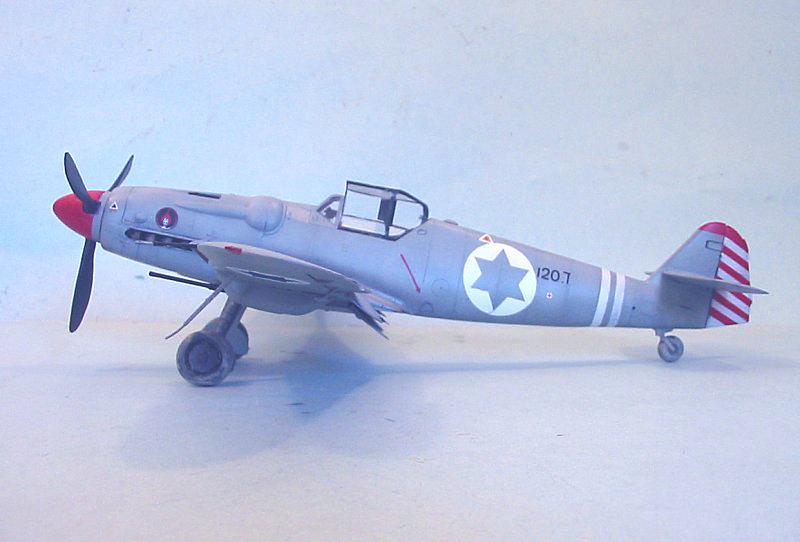
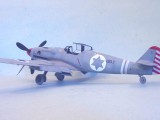
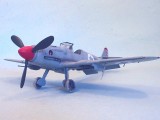
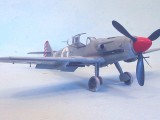
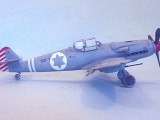
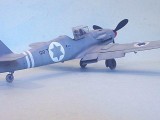
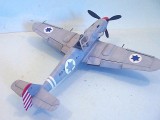

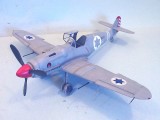
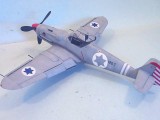
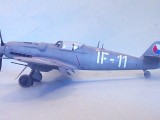
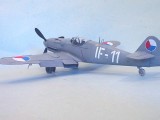
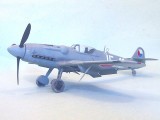
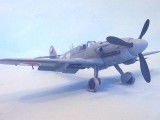
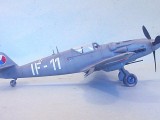
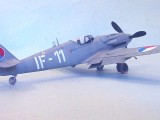
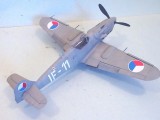
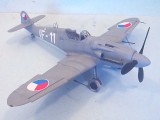
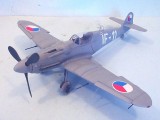

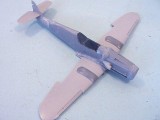

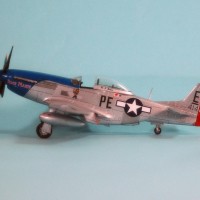

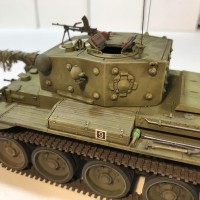
Love your "mule" Tom. Despite it (the aircraft) being a real handfull to fly it did indeed provide sterling service to the IAF. Theres a good article on the Mule & the Buchon in the latest issue of Aviation Classics (no.18) all about the Bf 109 well worth getting for all 109 fans.